Molecular basis of Inheritance NCERT
Quiz Summary
0 of 60 Questions completed
Questions:
Information
You have already completed the quiz before. Hence you can not start it again.
Quiz is loading…
You must sign in or sign up to start the quiz.
You must first complete the following:
Results
Results
0 of 60 Questions answered correctly
Your time:
Time has elapsed
You have reached 0 of 0 point(s), (0)
Earned Point(s): 0 of 0, (0)
0 Essay(s) Pending (Possible Point(s): 0)
Categories
- Not categorized 0%
- 1
- 2
- 3
- 4
- 5
- 6
- 7
- 8
- 9
- 10
- 11
- 12
- 13
- 14
- 15
- 16
- 17
- 18
- 19
- 20
- 21
- 22
- 23
- 24
- 25
- 26
- 27
- 28
- 29
- 30
- 31
- 32
- 33
- 34
- 35
- 36
- 37
- 38
- 39
- 40
- 41
- 42
- 43
- 44
- 45
- 46
- 47
- 48
- 49
- 50
- 51
- 52
- 53
- 54
- 55
- 56
- 57
- 58
- 59
- 60
- Current
- Review
- Answered
- Correct
- Incorrect
-
Question 1 of 60
1. Question
1 point(s)The figure shows a polynucleotide chain.

\(
\begin{array}{|l|l|}
\hline \begin{array}{l}
\text { Statement } \\
\text { I: }
\end{array} & \begin{array}{l}
\text { A is the 5′ end of the polynucleotide chain and } \\
\text { B is the 3′ end of the polynucleotide chain. }
\end{array} \\
\hline \begin{array}{l}
\text { Statement } \\
\text { II: }
\end{array} & \begin{array}{l}
\text { The nitrogenous bases linked to sugar moiety } \\
\text { project from the backbone. }
\end{array} \\
\hline
\end{array}
\)CorrectIncorrectHint
(d)
-
Question 2 of 60
2. Question
1 point(s)Consider the following Statements :-
\(
\begin{array}{|l|l|}
\hline \text { I: } & \begin{array}{l}
\text { DNA – deoxyribonucleic acid – is the genetic } \\
\text { material, at least for the majority of organisms. }
\end{array} \\
\hline \text { II: } & \begin{array}{l}
\text { RNA though it also acts as a genetic material in some } \\
\text { viruses, mostly functions as a messenger. }
\end{array} \\
\hline \text { III. } & \begin{array}{l}
\text { RNA can function as an adapter, structural, and in } \\
\text { some cases as a catalytic molecule. }
\end{array} \\
\hline
\end{array}
\)CorrectIncorrectHint
(a)
-
Question 3 of 60
3. Question
1 point(s)Study the structure of double-stranded nucleotide chain given below and select the correct statements :
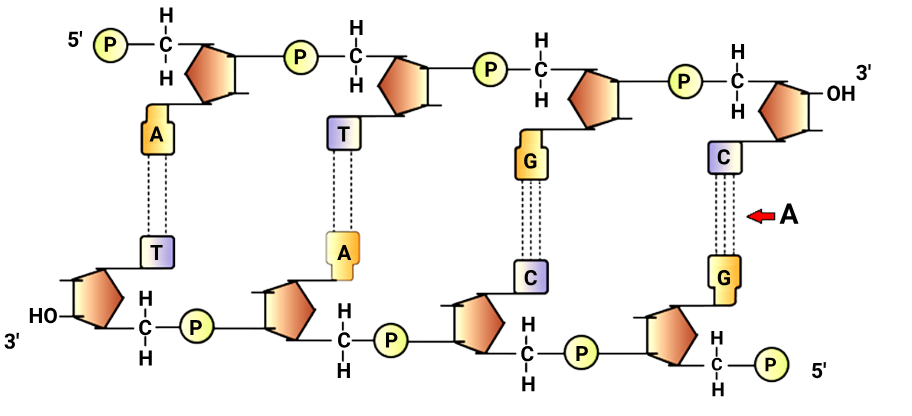
\(
\begin{array}{|l|l|}
\hline \begin{array}{l}
\text { Statement } \\
\text { I: }
\end{array} & \begin{array}{l}
\text { A shows the hydrogen bonds where a triple } \\
\text { bond links Guanine and Cytosine and a double } \\
\text { bond links Adenine and Thymine. }
\end{array} \\
\hline \begin{array}{l}
\text { Statement } \\
\text { II: }
\end{array} & \begin{array}{l}
\text { If Adenine in such a dsDNA molecule is } \\
\text { found to be } 20 \%, \text { the amount of Cytosine in } \\
\text { this ds DNA molecule is expected to be } 20 \% .
\end{array} \\
\hline
\end{array}
\)CorrectIncorrectHint
(c)
I: Strands are antiparallel ❌ Incorrect Diagram shows both strands as parallel (5′ → 3′ same direction) II: Base pairing follows Chargaff’s rule ❌ Incorrect Base pairs shown on same strand polarity (e.g., G≡C both on 5′ ends), which violates actual base pairing rules -
Question 4 of 60
4. Question
1 point(s)To form a nucleoside, a nitrogenous base is linked to a pentose sugar :
\(
\begin{array}{|c|l|}
\hline \text { 1. } & \begin{array}{l}
\text { Through a P-Glycosidic linkage at carbon atom } \\
\text { number 1 }
\end{array} \\
\hline \text { 2. } & \begin{array}{l}
\text { Through a P-Glycosidic linkage at carbon atom } \\
\text { number 5 }
\end{array} \\
\hline \text { 3. } & \begin{array}{l}
\text { Through an N-Glycosidic linkage at carbon atom } \\
\text { number 1 }
\end{array} \\
\hline \text { 4. } & \begin{array}{l}
\text { Through an N-Glycosidic linkage at carbon atom } \\
\text { number 5 }
\end{array} \\
\hline
\end{array}
\)CorrectIncorrectHint
(c)
-
Question 5 of 60
5. Question
1 point(s)The diagram shows the DNA double helix. What will be true for the helix ?
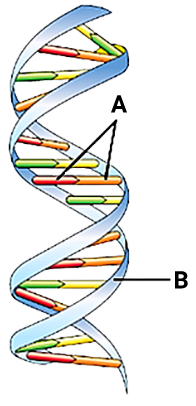
\(
\begin{array}{|l|l|}
\hline \text { I. } & \begin{array}{l}
\text { A represents a base pair where the plane of one base } \\
\text { pair stacks over the other in the double helix giving } \\
\text { the helix more stability in addition to hydrogen } \\
\text { bonds. }
\end{array} \\
\hline \text { II. } & \begin{array}{l}
\text { There are } 10 \text { base pairs in one complete turn of B- } \\
\text { dNA. }
\end{array} \\
\hline \text { III. } & \text { B is the backbone constituted by sugar-phosphate. } \\
\hline \text { IV. } & \begin{array}{l}
\text { The two strands are parallel-oriented in the same } \\
\text { direction with respect to each other. }
\end{array} \\
\hline \text { V: } & \text { The diameter is uniform, around } 2.0 \mathrm{~nm} . \\
\hline
\end{array}
\)CorrectIncorrectHint
(c)
IV : The two stands are anti parallel not parallel
-
Question 6 of 60
6. Question
1 point(s)According to Erwin Chargaff, in a double-stranded DNA :-
CorrectIncorrectHint
(a)
-
Question 7 of 60
7. Question
1 point(s)The central dogma of molecular biology is an explanation of the flow of genetic information within a biological system :

Statement I: A is ‘replication‘ where DNA is replicated in a semi-conservative manner.
Statement II: B is ‘transcription‘ and is so called because the language of RNA is only a slight variant of the language of the DNA.
Statement III: C is ‘translation‘ and is so called because the language of Protein is entirely different from the language of RNA.CorrectIncorrectHint
(c)
All correct
-
Question 8 of 60
8. Question
1 point(s)CorrectIncorrect -
Question 9 of 60
9. Question
1 point(s)CorrectIncorrect -
Question 10 of 60
10. Question
1 point(s)CorrectIncorrect -
Question 11 of 60
11. Question
1 point(s)The structure of nucleosome is shown below :

I: A is H1 histone.
II: B is a tetramer made of histone proteins.CorrectIncorrect -
Question 12 of 60
12. Question
1 point(s)CorrectIncorrect -
Question 13 of 60
13. Question
1 point(s)CorrectIncorrect -
Question 14 of 60
14. Question
1 point(s)The given figure shows the Electron Microscope ‘beads-on-string’ structure of :
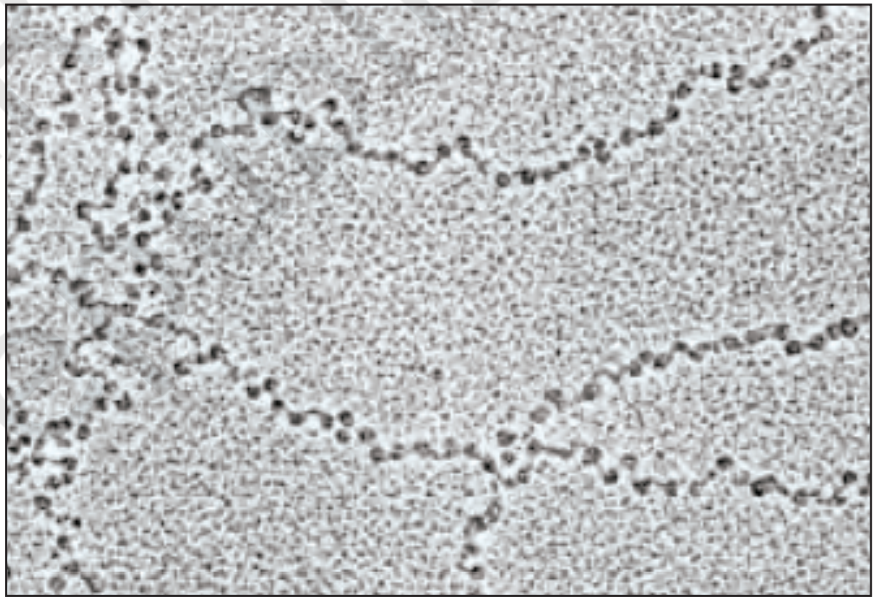 CorrectIncorrect
CorrectIncorrectHint
(a)
-
Question 15 of 60
15. Question
1 point(s)Given below are two statements : one is labelled as Assertion (A) and the other is labelled as Reason (R).
\(
\begin{array}{|l|l|}
\hline \text { Assertion (A): } & \begin{array}{l}
\text { The distance between the two strands of } \\
\text { the DNA helix is approximately uniform. }
\end{array} \\
\hline \text { Reason (R): } & \begin{array}{l}
\text { base pairing is complementary where a } \\
\text { purine always base pairs with a } \\
\text { pyrimidine and a pyrimidine always base } \\
\text { pairs with a purine. }
\end{array} \\
\hline
\end{array}
\)
In the light of the above statements, choose the most appropriate answer from the options given below :CorrectIncorrectHint
(a)
-
Question 16 of 60
16. Question
1 point(s)Consider the two statements:
\(
\begin{array}{|l|l|}
\hline \text { I: } & \begin{array}{l}
\text { If the sequence of bases in one strand of a double- } \\
\text { stranded DNA is known, then the sequence in other } \\
\text { strands can be predicted. }
\end{array} \\
\hline \text { II: } & \begin{array}{l}
\text { If each strand from a DNA acts as a template for the } \\
\text { synthesis of a new strand, the two double-stranded } \\
\text { DNA thus, produced would be identical to the } \\
\text { parental DNA molecule. }
\end{array} \\
\hline
\end{array}
\)CorrectIncorrectHint
(c)
-
Question 17 of 60
17. Question
1 point(s)Histones are rich in amino acids :
CorrectIncorrectHint
(a)
-
Question 18 of 60
18. Question
1 point(s)Study the illustration of the basic steps of the Hershey–Chase experiment and select the correct statements from the given experiments :
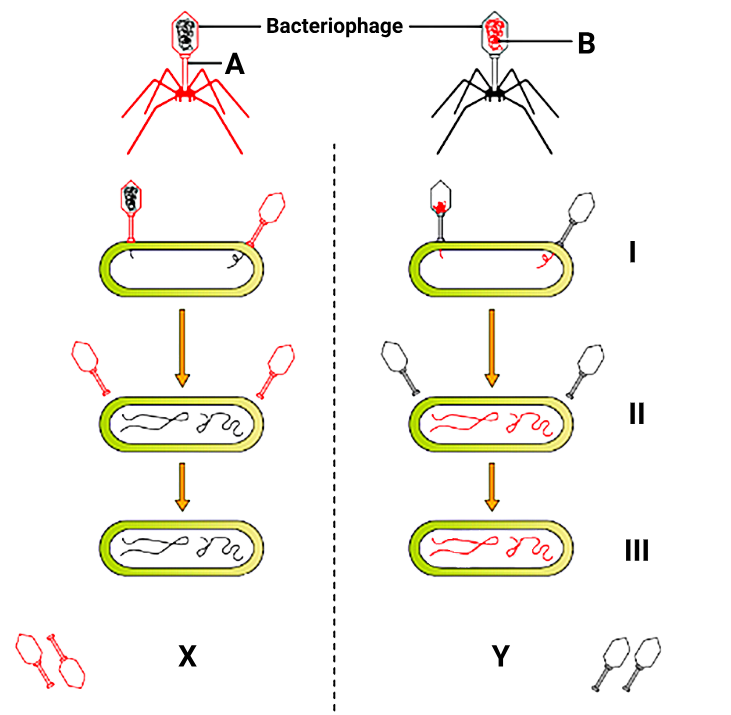
I: ‘A‘ shows that viruses grown on radioactive sulfur contained radioactive protein but not radioactive DNA because DNA does not contain sulfur.
II. ‘B‘ shows that viruses are grown in the presence of radioactive phosphorus contained radioactive DNA but not radioactive protein because DNA contains phosphorus but protein does not.
III: The result ‘X‘ shows bacteria that were infected with viruses that had radioactive DNA were radioactive, indicating that DNA was the material.
IV. The result ‘Y‘ shows bacteria that were infected with viruses that had radioactive proteins were not radioactive indicating that proteins did not enter the bacteria from the viruses.CorrectIncorrectHint
(a)
Statement III:- ❌ Incorrect – ‘X’ is the left panel (‘A’), which used radioactive sulfur (protein), and the bacteria did not become radioactive.
Statement IV:- ❌ Incorrect – this actually mixes up the panels:
-
Question 19 of 60
19. Question
1 point(s)Given below are two statements : one is labelled as
Assertion (A) and the other is labelled as Reason (R).
\(
\begin{array}{|l|l|}
\hline \text { Assertion (A): } & \begin{array}{l}
\text { A set of positively charged and basic } \\
\text { proteins are used in the packaging of } \\
\text { Eukaryotic DNA. }
\end{array} \\
\hline \text { Reason (R): } & \begin{array}{l}
\text { DNA molecule is acid and carries a } \\
\text { negative charge. }
\end{array} \\
\hline
\end{array}
\)
In the light of the above statements, choose the most appropriate answer from the options given below :CorrectIncorrectHint
(a)
-
Question 20 of 60
20. Question
1 point(s)During DNA packaging in eukaryotic cells, Non-Histone Chromosomal proteins :
CorrectIncorrectHint
(d)
-
Question 21 of 60
21. Question
1 point(s)Given below are two statements : one is labelled as
Assertion (A) and the other is labelled as Reason (R).
\(
\begin{array}{|l|l|}
\hline \text { Assertion (A): } & \begin{array}{l}
\text { Euchromatin is said to transcriptionally } \\
\text { active protein. }
\end{array} \\
\hline \text { Reason (R): } & \begin{array}{l}
\text { Heterochromatin is said to be } \\
\text { transcriptionally inactive. }
\end{array} \\
\hline
\end{array}
\)
In the light of the above statements, choose the most appropriate answer from the options given below :CorrectIncorrectHint
(b)
❌ Why R does NOT explain A:
-
Saying heterochromatin is inactive doesn’t explain why euchromatin is active.
-
It just provides a contrasting fact, not a causal reason.
-
An actual explanation of (A) would involve stating that loose packing in euchromatin allows easy access to transcription machinery.
-
Question 22 of 60
22. Question
1 point(s)The given Fig. Shows :-
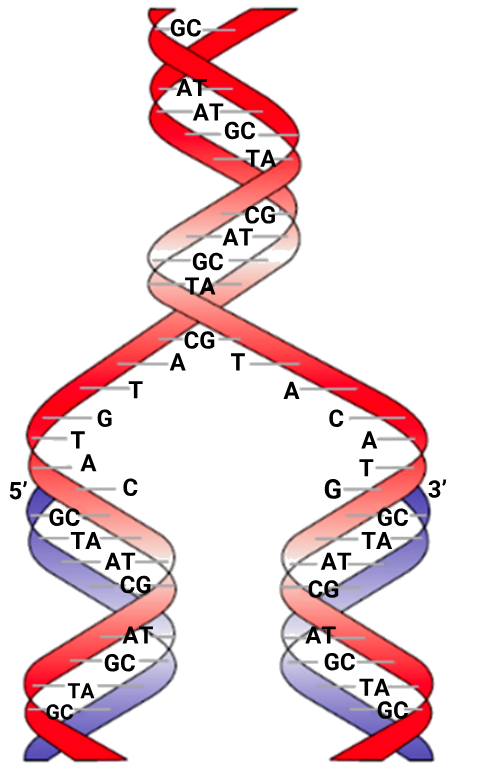 CorrectIncorrect
CorrectIncorrectHint
(a)
-
Question 23 of 60
23. Question
1 point(s)In Griffith’s experiment, which of the following bacterial strains was capable of causing pneumonia in mice ?
CorrectIncorrectHint
(b)
-
Question 24 of 60
24. Question
1 point(s)Given below are two statements : one is labelled as
Assertion (A) and the other is labelled as Reason (R).
\(
\begin{array}{|l|l|}
\hline \text { Assertion (A): } & \begin{array}{l}
\text { S-strain of Streptococcus pneumoniae is } \\
\text { virulent. }
\end{array} \\
\hline \text { Reason (R): } & \begin{array}{l}
\text { Heat-killed S-strain Streptococcus } \\
\text { pneumoniae injected into mice did not } \\
\text { cause pneumonia and did not kill them. }
\end{array} \\
\hline
\end{array}
\)
In the light of the above statements, choose the most appropriate answer from the options given below :CorrectIncorrectHint
(c)
❌ Why R does not explain A:
-
Assertion (A) is stating why the live S-strain is virulent (due to its capsule).
-
But Reason (R) is about the heat-killed S-strain, which is no longer virulent.
-
So, R is not giving the reason for A’s virulence, it’s just another observation from the experiment.
-
Question 25 of 60
25. Question
1 point(s)Given below are two statements : one is labelled as
Assertion (A) and the other is labelled as Reason (R).
\(
\begin{array}{|l|l|}
\hline \text { Assertion (A): } & \begin{array}{l}
\text { In Avery, Macleod, and McCarty’s } \\
\text { experiment, digestion of heat-killed } \\
\text { lysate with proteases and RNases did not } \\
\text { affect transformation but digestion with } \\
\text { DNase did. }
\end{array} \\
\hline \text { Reason (R): } & \begin{array}{l}
\text { DNase will hydrolyse all biomolecules in } \\
\text { the lysate except DNA. }
\end{array} \\
\hline
\end{array}
\)
In the light of the above statements, choose the most appropriate answer from the options given below :CorrectIncorrectHint
(a)
-
Question 26 of 60
26. Question
1 point(s)The figure shows the Meselson and Stahl experiment. Identify the correct statements :
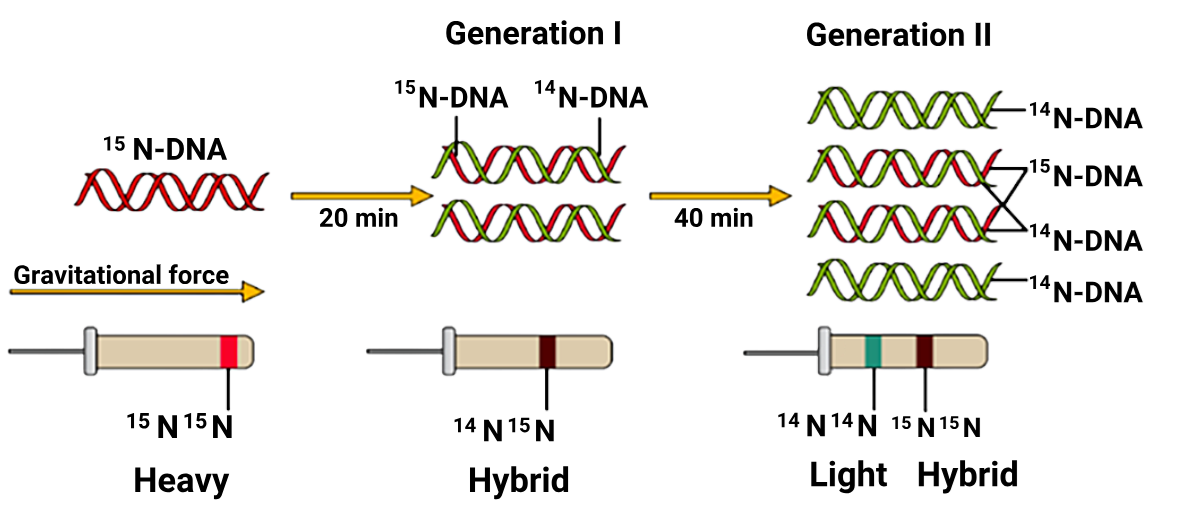
I: The result at the end of 20 minutes excludes the ‘conservative’ mode of DNA replication.
II: The result at the end of 40 minutes excludes the ‘dispersive’ mode of DNA replication.CorrectIncorrectHint
(d)
-
Question 27 of 60
27. Question
1 point(s)Given below are two statements : one is labelled as
Assertion (A) and the other is labelled as Reason (R)
\(
\begin{array}{|l|l|}
\hline \text { Assertion (A): } & \begin{array}{l}
\text { Even after the results of Avery, Macleod, } \\
\text { and McCarty’s experiment, not all } \\
\text { biologists were convinced that DNA is } \\
\text { hereditary material. }
\end{array} \\
\hline \text { Reason (R): } & \begin{array}{l}
\text { Proteins were conclusively proved to be } \\
\text { the genetic material for almost all living } \\
\text { organisms. }
\end{array} \\
\hline
\end{array}
\)
In the light of the above statements, choose the most appropriate answer from the options given below :CorrectIncorrectHint
(d)
🔶 Reason (R):
“Proteins were conclusively proved to be the genetic material for almost all living organisms.”
❌ This is false.
-
Proteins were believed (not proved) to be genetic material before Avery’s and Hershey-Chase’s experiments.
-
But after Hershey-Chase (1952), it became conclusively proven that DNA, not proteins, is the genetic material (in viruses and cells).
So: (R) is false.
-
Question 28 of 60
28. Question
1 point(s)Given below are two statements : one is labelled as
Assertion (A) and the other is labelled as Reason (R).
\(
\begin{array}{|l|l|}
\hline \text { Assertion (A): } & \begin{array}{l}
\text { A molecule that can act as a genetic } \\
\text { material should be able to express itself } \\
\text { in the form of ‘Mendelian Characters’. }
\end{array} \\
\hline \text { Reason (R): } & \begin{array}{l}
\text { A molecule that can act as a genetic } \\
\text { material should provide the scope for } \\
\text { slow changes. }
\end{array} \\
\hline
\end{array}
\)
In the light of the above statements, choose the most appropriate answer from the options given below :CorrectIncorrectHint
(a)
-
Question 29 of 60
29. Question
1 point(s)Consider the two statements:-
\(
\begin{array}{|l|l|}
\hline \begin{array}{l}
\text { Statement } \\
\text { I: }
\end{array} & \begin{array}{l}
\text { There is now enough evidence to suggest that } \\
\text { essential life processes (such as metabolism, } \\
\text { translation, splicing, etc.), evolved around } \\
\text { RNA. }
\end{array} \\
\hline \begin{array}{l}
\text { Statement } \\
\text { II: }
\end{array} & \begin{array}{l}
\text { DNA being double-stranded and having } \\
\text { complementary strands further resists changes } \\
\text { by evolving a process of repair. }
\end{array} \\
\hline
\end{array}
\)CorrectIncorrectHint
(a)
-
Question 30 of 60
30. Question
1 point(s)The figure shows the replicating fork during DNA replication. Identify the correct statements.
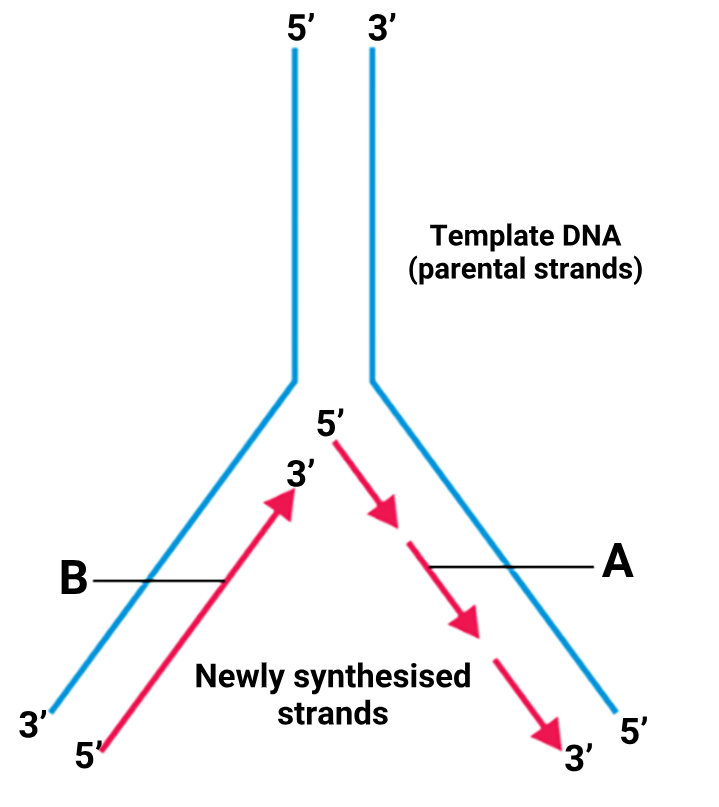
Statement I: A is an Okazaki fragment and such fragments make up the lagging strand which is replicated away from the replication fork.
Statement II: B is the leading strand that is continuously replicated towards the replication fork.CorrectIncorrect -
Question 31 of 60
31. Question
1 point(s)Who proposed a semi-conservative mode of replication for DNA?
CorrectIncorrectHint
(a)
-
Question 32 of 60
32. Question
1 point(s)The daughter DNA that was extracted from the culture one generation after the transfer from \(
{ }^{15} \mathrm{~N} \text { to }{ }^{14} \mathrm{~N}
\) medium had:CorrectIncorrectHint
(b)
What happens after 1 generation?
-
In semi-conservative replication, each daughter DNA molecule gets:
-
1 old (heavy) strand from 15N{}^{15}\mathrm{N}15N
-
1 new (light) strand from 14N{}^{14}\mathrm{N}14N
-
✅ Therefore, both daughter DNA molecules have one heavy and one light strand.
➡️ This makes the DNA have intermediate density, which was observed in cesium chloride (CsCl) gradient centrifugation.
-
Question 33 of 60
33. Question
1 point(s)Given below are two statements : One is labelled as Assertion (A) and the other is labelled as Reason (R).
\(
\begin{array}{|l|l|}
\hline \text { Assertion (A): } & \begin{array}{l}
\text { Deoxyribonulceoside triphosphates } \\
\text { provide energy for polymerization } \\
\text { reactions during the replication of DNA. }
\end{array} \\
\hline \text { Reason (R): } & \begin{array}{l}
\text { The two terminal phosphates in a } \\
\text { deoxynucleoside triphosphate are high- } \\
\text { energy phosphates, the same as in the } \\
\text { case of ATP. }
\end{array} \\
\hline
\end{array}
\)
In the light of the above statements, choose the most appropriate answer from the options given below :CorrectIncorrectHint
(d)
-
Question 34 of 60
34. Question
1 point(s)The figure shows the process of transcription in eukaryotes. Identify the incorrect statements regarding the process :
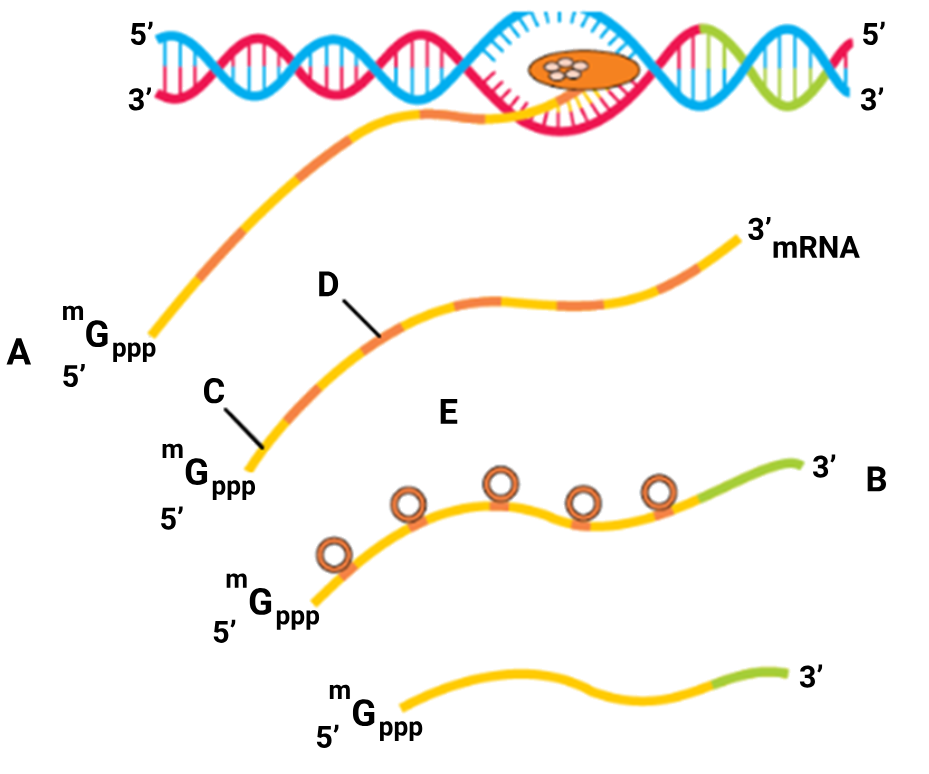 CorrectIncorrect
CorrectIncorrectHint
(b)
II:-❌ Why it is incorrect:
- Wrong number of adenylates:
- Actual poly-A tail added at the 3′ end = 200–300 adenine (A) residues,
- NOT just 20–30 as stated.
2. Wrong mechanism:
- Polyadenylation is template-independent,
- It doesn’t require a DNA template — a special enzyme (poly-A polymerase) adds the adenines after transcription ends.
✅ Correct version should be:
Polyadenylation adds 200–300 adenylate residues to the 3′ end of pre-mRNA in a template-independent manner.III:- ❌ Why it is incorrect:
Misleading wording:- It says “C constitute the sequences of the split gene”,
- This implies that only C (introns) make up the split gene,
Which is wrong — split genes contain both introns (C) and exons (D).
✅ It’s true that C (introns) do not appear in mature RNA,
But saying C “constitute the split gene” is incomplete and misleading.
✅ Correct version should be:
“C are introns, which are part of the split gene and are removed during RNA splicing.” -
Question 35 of 60
35. Question
1 point(s)Consider the following statements :
\(
\begin{array}{|l|l|}
\hline \text { I. } & \begin{array}{l}
\text { Deoxyribonucleoside triphosphates act as substrates } \\
\text { as well as provide energy for polymerization reaction } \\
\text { during DNA replication. }
\end{array} \\
\hline \text { II. } & \begin{array}{l}
\text { The replication of DNA is both semiconservative and } \\
\text { semi-discontinuous }
\end{array} \\
\hline \text { III. } & \begin{array}{l}
\text { In bacterial DNA replication, there are multiple ori } \\
\text { and replication fork moving bi-directionally }
\end{array} \\
\hline
\end{array}
\)
Which of the above statements are true ?CorrectIncorrectHint
(a)
Statement III :- ❌ False.
- In prokaryotes like E. coli:
- There is only one origin of replication (oriC) per circular DNA molecule.
- The replication is bidirectional, i.e., two replication forks move in opposite directions.
- The statement incorrectly says “multiple ori”, which applies to eukaryotic DNA, not bacterial.
-
Question 36 of 60
36. Question
1 point(s)Given below are two statements : one is labelled as Assertion (A) and the other is labelled as Reason (R).
\(
\begin{array}{|l|l|}
\hline \text { Assertion (A): } & \begin{array}{l}
\text { For long DNA molecules, the replication } \\
\text { occurs within a small opening of the } \\
\text { DNA helix, referred to as the replication } \\
\text { fork. }
\end{array} \\
\hline \text { Reason (R): } & \begin{array}{l}
\text { The DNA polymerases on their own } \\
\text { cannot initiate the process of replication. }
\end{array} \\
\hline
\end{array}
\)
In the light of the above statements, choose the most appropriate answer from the options given below :CorrectIncorrectHint
(b)
-
Question 37 of 60
37. Question
1 point(s)The DNA dependent polymerases catalyze:
CorrectIncorrectHint
(b)
-
Question 38 of 60
38. Question
1 point(s)The codons represented as YYY and ZZZ in the given figure, respectively, can be :
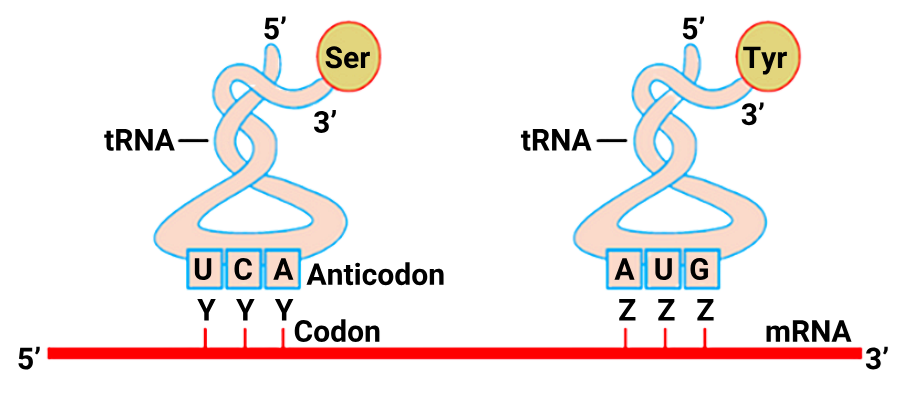 CorrectIncorrect
CorrectIncorrectHint
(a)
-
Question 39 of 60
39. Question
1 point(s)Given below are two statements : one is labelled as Assertion (A) and the other is labelled as Reason (R).
\(
\begin{array}{|l|l|}
\hline \text { Assertion (A): } & \begin{array}{l}
\text { A piece of DNA if needed to be } \\
\text { propagated during recombinant DNA } \\
\text { procedures requires a vector. }
\end{array} \\
\hline \text { Reason (R): } & \begin{array}{l}
\text { The vectors provide the origin of } \\
\text { replication. }
\end{array} \\
\hline
\end{array}
\)
In the light of the above statements, choose the most appropriate answer from the options given below :CorrectIncorrectHint
(a)
-
Question 40 of 60
40. Question
1 point(s)Given below are two statements : one is labelled as Assertion (A) and the other is labelled as Reason (R)
\(
\begin{array}{|l|l|}
\hline \text { Assertion (A): } & \begin{array}{l}
\text { The replication of DNA and cell division } \\
\text { cycle should be highly coordinated. }
\end{array} \\
\hline \text { Reason (R): } & \begin{array}{l}
\text { In eukaryotes, the replication of DNA } \\
\text { takes place at the S-phase of the cell } \\
\text { cycle. }
\end{array} \\
\hline
\end{array}
\)
In the light of the above statements, choose the most appropriate answer from the options given below :CorrectIncorrectHint
(a)
Now: Does (R) explain (A)?
Let’s rephrase both:
-
(A): DNA replication and cell division must be synchronized.
-
(R): DNA replication happens in the S-phase.
➡️ R gives a fact (timing of replication), but it does not directly explain why coordination is needed, or how it’s ensured.
So, while both A and R are correct individually, R doesn’t explain A fully — it states when replication occurs, not why coordination is essential.
-
Question 41 of 60
41. Question
1 point(s)What defines a coding and a template strand in the transcription unit ?
CorrectIncorrectHint
(a)
-
Question 42 of 60
42. Question
1 point(s)In the given figure Identify A to D :-
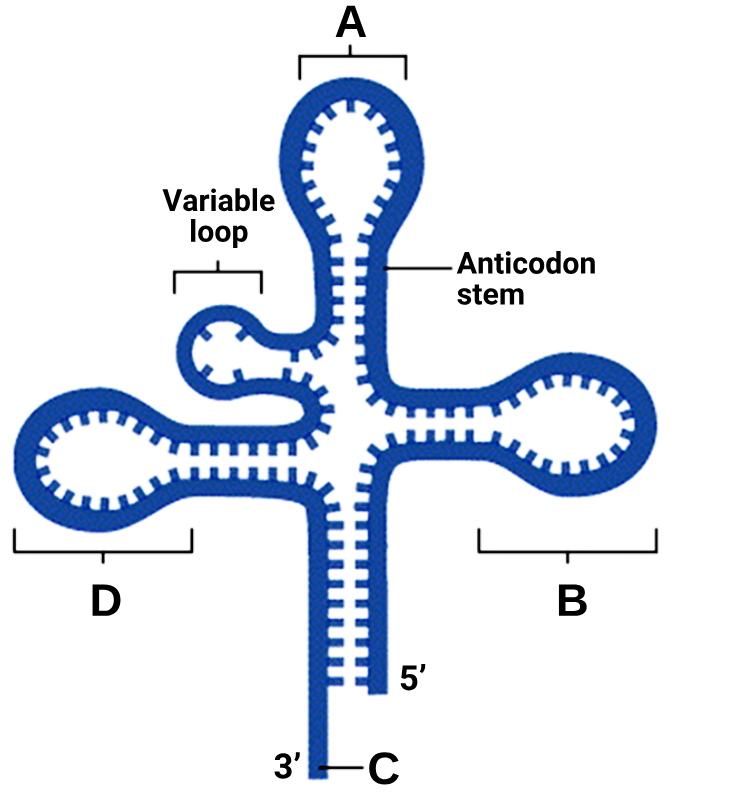
\(
\begin{array}{|l|l|l|l|l|}
\hline & \text { A } & \text { B } & \text { C } & \text { D } \\
\hline \text { 1. } & \text { Amino acid binding site } & \text { DHU loop } & \text { Anticodon } & \text { T } \Psi \text { loop } \\
\hline \text { 2. } & \text { Amino acid binding site } & \text { T } \Psi \text { C loop } & \text { Anticodon } & \text { DHU loop } \\
\hline \text { 3. } & \text { Anticodon } & \text { DHU loop } & \text { Amino acid binding site } & \text { T } \Psi \text { C loop } \\
\hline \text { 4. } & \text { Anticodon } & \text { T } \Psi \text { C loop } & \text { Amino acid binding site } & \text { DHU loop } \\
\hline
\end{array}
\)CorrectIncorrectHint
(c)
-
Question 43 of 60
43. Question
1 point(s)Consider the following statements :
\(
\begin{array}{|c|l|}
\hline \text { I. } & \begin{array}{l}
\text { All the reference point while defining a transcription } \\
\text { unit is made with the coding strand. }
\end{array} \\
\hline \text { II. } & \begin{array}{l}
\text { It is the presence of a promoter in a transcription unit } \\
\text { that also defines the template and coding strands. }
\end{array} \\
\hline \text { III. } & \begin{array}{l}
\text { Exons are said to be sequences that do not appear in } \\
\text { mature or processed RNA. }
\end{array} \\
\hline
\end{array}
\)
Which of the above statements are true ?CorrectIncorrectHint
(a)
III: ❌ False
-
Exons are expressed regions — they do appear in the mature mRNA after splicing.
-
It is the introns that are removed during RNA processing.
🔴 Incorrect
-
Question 44 of 60
44. Question
1 point(s)Study the diagram of the lac operon given below and select the correct statements :

Statement I: This is the working of a lac operon in the absence of an inducer.
Statement II: Repressor binds to the operator region and allows RNA polymerase to transcribe the operon.CorrectIncorrectHint
(a)
Statement II :- Repressor binds to the operator region and BLOCK RNA polymerase to transcribe the operon.
-
Question 45 of 60
45. Question
1 point(s)Given below are two statements : one is labelled as Assertion (A) and the other is labelled as Reason (R)
\(
\begin{array}{|l|l|}
\hline \text { Assertion (A): } & \begin{array}{l}
\text { It is necessary to define the boundaries } \\
\text { that would demarcate the region and the } \\
\text { strand of DNA that would be transcribed. }
\end{array} \\
\hline \text { Reason (R): } & \begin{array}{l}
\text { Reason: Both strands of DNA are not } \\
\text { copied during transcription. }
\end{array} \\
\hline
\end{array}
\)
In the light of the above statements, choose the most appropriate answer from the options given below :CorrectIncorrectHint
(d)
Because R explains why we choose a strand,
but does not explain why we define the region/boundaries (start and stop of transcription). -
Question 46 of 60
46. Question
1 point(s)CorrectIncorrect -
Question 47 of 60
47. Question
1 point(s)Consider the transcription unit given in the following diagram and choose the correct statements :

I. The promoter on the promoter is situated upstream and 5′ to the structural gene.
II. It is the presence of the structural gene that defines the template strand.
III. The coding strand does not code for anything and is displaced during transcriptionCorrectIncorrectHint
(b)
✅ Final one-line explanation:
Statement II is incorrect because it falsely implies that the gene determines the template strand, whereas in reality, the promoter’s orientation decides which DNA strand will serve as the template.
Detailed Explanantion:-
❌ Why this is incorrect:
- In transcription, the template strand is chosen not by the structural gene itself,
but by the location and orientation of the promoter region. - Promoter sequences are strand-specific and located upstream of the structural gene.
- Once RNA polymerase binds to the promoter, it proceeds in one direction only (3′ → 5′ on the template strand), determining which strand will be used.
-
Question 48 of 60
48. Question
1 point(s)CorrectIncorrect -
Question 49 of 60
49. Question
1 point(s)Study the diagram given below and choose the correct information that can be deduced :
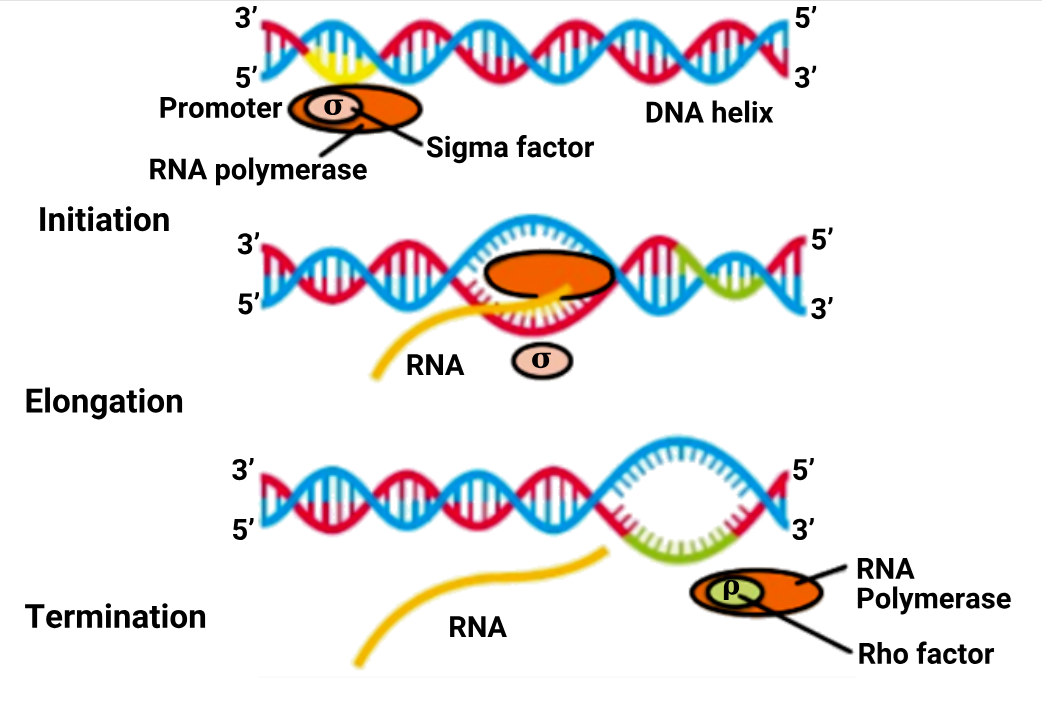 CorrectIncorrect
CorrectIncorrectHint
(a)
-
Question 50 of 60
50. Question
1 point(s)CorrectIncorrect -
Question 51 of 60
51. Question
1 point(s)CorrectIncorrect -
Question 52 of 60
52. Question
1 point(s)Consider the following diagram showing the working of the lac operon in E.coli in the presence of an inducer and choose the correct statement from the ones given below :
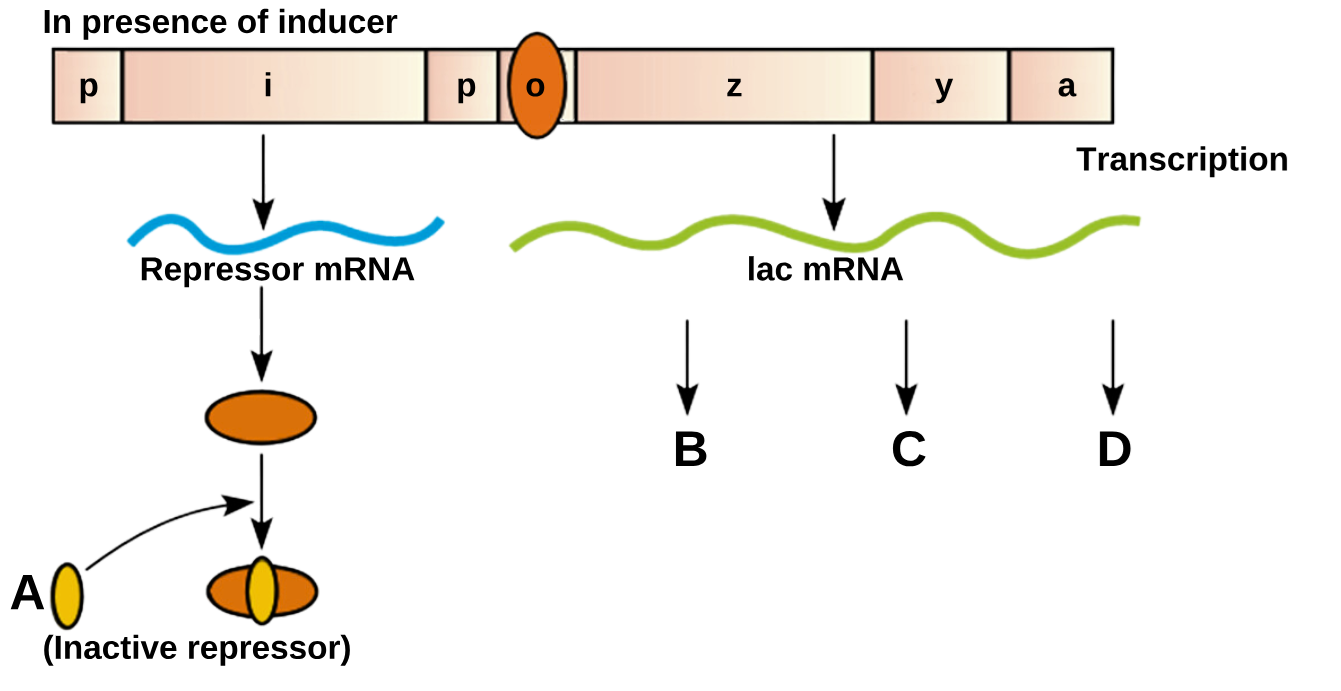 CorrectIncorrect
CorrectIncorrectHint
(c)
Identity Functions
A Inducer (lactose or allolactose} Binds repressor, inactivates it
B β-galactosidase (from lacZ) Breaks lactose into glucose + galactose
C Permease (from lacY) Helps lactose enter the cell
D Transacetylase (from lacA) Role unclear in lactose metabolism1. A is the inducer and can be either lactose or cAMP.
→ ❌ Incorrect: Inducer is lactose/allolactose, not cAMP (which regulates via CAP, not the repressor).2. B is the enzyme that will metabolize glucose, the preferred energy source.
→ ❌ Incorrect: B is β-galactosidase, which metabolizes lactose, not glucose.3. Some amount of C will be present in the cell even if lactose is absent.
→ ✅ Correct: C is permease, and due to basal expression, it’s present in small amounts always.4. The absence of D will stop lactose from entering the cell.
→ ❌ Incorrect: D is transacetylase, which has no role in lactose transport; C (permease) does that. -
Question 53 of 60
53. Question
1 point(s)CorrectIncorrect -
Question 54 of 60
54. Question
1 point(s)Given below are two statements : one is labelled as Assertion (A) and the other is labelled as Reason (R)
\(
\begin{array}{|l|l|}
\hline \text { Assertion (A): } & \begin{array}{l}
\text { Both the strands of DNA are not copied } \\
\text { during transcription. }
\end{array} \\
\hline \text { Reason (R): } & \begin{array}{l}
\text { Both strands of DNA are identical in } \\
\text { their base composition. }
\end{array} \\
\hline
\end{array}
\)
In the light of the above statements, choose the most appropriate answer from the options given below :CorrectIncorrectHint
(a)
Statement II :❌ False
- This is factually incorrect.
- The two DNA strands are complementary, not identical:
For example:
- One strand: 5’–ATGC–3’
- Other strand: 3’–TACG–5’
❌ So, the Reason is FALSE.
-
Question 55 of 60
55. Question
1 point(s)CorrectIncorrectHint
(d)
❌ Option 4: The smaller chromosomes in the human genome have smaller repeats of VNTR
→ False / Cannot be inferred — The size of chromosomes is not related to VNTR size. VNTR length depends on number of repeat units, not chromosome size.
The diagram does not show any link between chromosome size and VNTR length. -
Question 56 of 60
56. Question
1 point(s)Which of the following is true for both transcription and DNA replication ?
CorrectIncorrectHint
(a)
-
Question 57 of 60
57. Question
1 point(s)CorrectIncorrect -
Question 58 of 60
58. Question
1 point(s)The DNA profiles below represent four different individuals. Which of the following statements is consistent with the results ?
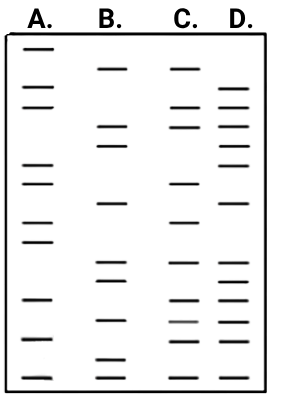 CorrectIncorrect
CorrectIncorrectHint
(b)
Step-by-step matching:
Let’s evaluate Option 3: D is the child of B and C.
Check if each band in D matches either B or C.Bands in D:
Top band — matches C
2nd band — matches C
3rd band — matches B
4th band — matches C
5th band — matches C
6th band — matches B
7th band — matches C
8th band — matches B
9th band — matches B✅ All bands in D are present in either B or C → Valid child of B and C
-
Option 1 (B is child of A and C) ❌ — B has middle bands not matching A or C.
-
Option 2 (C is child of A and B) ❌ — C has unique bands not found in either A or B.
-
Option 4 (A is child of B and C) ❌ — Top bands of A don’t match either B or C.
-
Question 59 of 60
59. Question
1 point(s)CorrectIncorrect -
Question 60 of 60
60. Question
1 point(s)Given below are two statements : one is labelled as Assertion (A) and the other is labelled as Reason (R)
\(
\begin{array}{|l|l|}
\hline \text { Assertion (A): } & \begin{array}{l}
\text { In transcription, the strand that does not } \\
\text { code for anything is referred to as the } \\
\text { coding strand. }
\end{array} \\
\hline \text { Reason (R): } & \begin{array}{l}
\text { It is the presence of the promoter in a } \\
\text { transcription unit that defines the } \\
\text { template and coding strands. }
\end{array} \\
\hline
\end{array}
\)
In the light of the above statements, choose the most appropriate answer from the options given below :CorrectIncorrectHint
(b)
🔴 Why R does not explain A:
-
R explains how the strands are selected,
-
But A makes a statement about the function of the coding strand (that it doesn’t code),
which is not explained or justified by the promoter’s role.